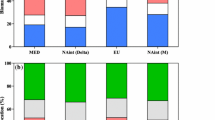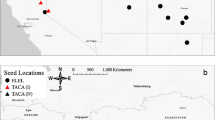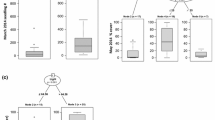Abstract
Understanding which plant traits confer invasiveness has been a central question in biological invasions research. Heterotheca subaxillaris (camphor-weed), an American plant, is an important invader of coastal sand dunes in Israel. Nevertheless, there has been no comprehensive comparative analysis of H. subaxillaris plant traits from native versus introduced habitats that sheds light on the invasion success of this species in Israel. I studied H. subaxillaris from native (US) versus introduced (Israel) populations to identify functional traits that accorded this species invasion success in Israel. Plant traits considered were shoot and root biomass production, root–shoot ratio, shoot height, root length, number of inflorescences, achene number and mass, and life span. Achenes (seeds) of all populations were germinated under common growing conditions to produce F1 achenes. F1 seedlings were grown in a large-scale common garden aeroponic system until flowering and then harvested. Introduced populations exhibited marked differences in measured parameters than native populations. Notably, root length of introduced populations exceeded 5 m, almost fourfold greater than that of native populations, allowing access to soil moisture and nutrients from deep sand layers and late-summer flowering. Life span of introduced populations almost doubled that of American populations. To the best of my knowledge, this is the first documentation of adaptive micro-evolutionary change favoring deep root allocation and phenological change in an invasive species in sand dunes. Seemingly, a rapid evolutionary change favoring root resource allocation occurred within introduced populations, allowing establishment, expansion, and successful invasion in the harsh ecosystem of Israel’s coastal sand dunes.


Similar content being viewed by others
References
Bar P, Cohen O, Shoshany M (2004) The invasion rate of the alien species Acacia saligna within the coastal sand dune habitats of Israel. Isr J Plant Sci 52:115–124
Baskin JM, Baskin CC (1976) Germination dimorphism in Heterotheca subaxillaris var. subaxillaris. B Torrey Bot Club 103:201–206
Bossdorf O, Auge H, Lafuma L, Rogers WE, Siemann E, Prati D (2005) Phenotypic and genetic differentiation between native and introduced plant populations. Oecologia 144:1–11
Bossdorf O, Lipowsky A, Prati D (2008) Selection of preadapted genotypes allowed Senecio inaequidens to invade Central Europe. Divers Distrib 14:676–685
Callaway RM, Maron JL (2006) What have exotic plant invasions taught us over the past 20 years? Trends Ecol Evol 7:369–374
Campos JA, Herrera M, Biurrun I, Loidi J (2004) The role of alien plants in the natural coastal vegetation in central—northern Spain. Biodivers Conserv 13:2275–2293
Dafni A, Heller D (1990) Invasions of adventive plants in Israel. In: Di Castri F, Hansen AJ, Debussche M (eds) Biological invasions in Europe and the Mediterranean basin. Kluwer Academic Publishers, Dordrecht, pp 135–160
Davidson AM, Jennions M, Nicotra AB (2011) Do invasive species show higher phenotypic plasticity than native species and if so, is it adaptive? A meta-analysis. Ecol Lett 14:419–431
Dlugosch KM, Parker IM (2008) Founding events in species invasions: genetic variation, adaptive evolution, and the role of multiple introductions. Mol Ecol 17:431–449
Donohue K, Schmitt J (1998) Maternal environmental effects: adaptive plasticity? In: Mousseau TA, Fox CW (eds) Maternal effects as adaptations. Oxford University Press, Oxford, pp 137–158
Drenovsky RE, Grewell BJ, D’Antonio CM, Funk JL, James JJ, Molinari N, Parker IM, Richards CL (2012) A functional trait perspective on plant invasion. Ann Bot 110:141–153
Dufour-Dror JM (2012) Alien invasive plants in Israel, 1st edn. Gefen Publishing, Jerusalem
Eshel A, Grünzweig J (2013) Root-shoot allometry of tropical forest trees determined in large-scale aeroponics. Ann Bot 112:291–296
Gibson JP, Tomlinson AD (2002) Genetic diversity and mating system comparisons between ray and disc achene seed pools of the heterocarpic species Heterotheca subaxillaris (Asteraceae). Int J Plant Sci 163:1025–1034
Gutterman Y (1992) Maternal effects on seeds during development. In: Fenner M (ed) Seeds: the ecology of regeneration in plant communities. CAB International, Wallingford, pp 59–84
Hairston NG, Ellner SP, Geber MA, Yoshida T, Fox JA (2005) Rapid evolution and the convergence of ecological and evolutionary time. Ecol Lett 8:1114–1127
Kolar CS, Lodge DM (2001) Progress in invasion biology: predicting invaders. Trends Ecol Evol 16:199–204
Kutiel P (2001) Conservation and management of the Mediterranean coastal sand dunes in Israel. J Coast Conserv 7:183–192
Kutiel P, Danin A (1987) Annual species diversity and above ground phytomass in relation to some soil properties in the sand dunes of the northern Sharon Plains, Israel. Vegetatio 70:45–49
Lonard RI, Judd FW, Stalter R (2011) Biological flora of coastal dunes and wetlands: Heterotheca subaxillaris (Lam.) Britton & Rusby. J Coast Res 27:1052–1058
Mack RN, Simberloff D, Lonsdale WM, Evans H, Clout M, Bazzaz FA (2000) Biotic invasions: causes, epidemiology, global consequences, and control. Ecol Appl 10:689–710
Morimoto M, Cantrell CL, Libous-Bailey L, Duke SO (2009) Phytotoxicity of constituents of glandular trichomes and the leaf surface of camphorweed, Heterotheca subaxillaris. Phytochemistry 70:69–74
Olsen KM (1997) Pollination effectiveness and pollinator importance in a population of Heterotheca subaxillaris (Asteraceae). Oecologia 109:114–121
Roche CT, Thill DC, Shafii B (1997) Reproductive phenology in yellow starthistle (Centaurea solstitialis). Weed Sci 47:763–770
Rodgers JC III, Parker KC (2003) Distribution of alien plant species in relation to human disturbance on the Georgia Sea Islands. Divers Distrib 9:385–398
Sakai AK, Allendorf FW, Holt JS, Lodge DM, Molofsky J, With KA, Baughman S, Cabin RJ, Cohen JE, Ellstrand NC, McCauley DE, O’Neil P, Parker IM, Thompson JN, Weller SG (2001) The population biology of invasive species. Ann Rev Ecol Syst 32:305–332
Schlaepfer DR, Glättli M, Fischer M, van Kleunen M (2010) A multispecies experiment in their native range indicates pre-adaptation of invasive alien plant species. New Phytol 185:1087–1099
Shipley B, Meziane D (2002) The balanced-growth hypothesis and the allometry of leaf and root biomass allocation. Funct Ecol 16:326–331
Sokal RR, Rohlf FJ (1995) Biometry: the principles and practice of statistics in biological research, 3rd edn. WH Freeman and Company, New York
Stanisci A, Acosta ATR, Di Iorio A, Vergalito M (2010) Leaf and root trait variability of alien and native species along Adriatic coastal dunes (Italy). Plant Biosyst 144:47–52
van Kleunen M, Dawson W, Essl F, Pergl J, Winter M, Weber E et al (2015) Global exchange and accumulation of non-native plants. Nature 525:100–103
Venable DL, Levin DA (1985) Ecology of achene dimorphism in Heterotheca latifolia. 1. Achene structure, germination and dispersal. J Ecol 73:133–145
Waisel Y (2002) Aeroponics: a tool for root research under minimal environmental restrictions. In: Waisel Y, Eshel A, Kafkafi U (eds) Plant roots: the hidden half, 3rd edn. Marcel Dekker, New York, pp 323–331
Acknowledgments
I thank Claus Holzapfel for the exchange of ideas about comparing native vs. invasive populations of H. subaxillaris. Thanks are also extended to Lauch Fraser for inviting me to be part of this special issue celebrating Roy Turkington’s retirement. I came to know Roy during one of his sabbatical stays in the Holy Land, and very much enjoyed discussing ecology and nature with him. This study was partly supported by internal funds from Tel Aviv University. The support of the Sarah Racine Root Research Laboratory at the Botanical Garden of Tel Aviv University is highly appreciated.
Author information
Authors and Affiliations
Corresponding author
Additional information
Communicated by Prof. Lauchlan Fraser, Dr. Chris Lortie, and Dr. JC Cahill.
Rights and permissions
About this article
Cite this article
Sternberg, M. From America to the Holy Land: disentangling plant traits of the invasive Heterotheca subaxillaris (Lam.) Britton & Rusby. Plant Ecol 217, 1307–1314 (2016). https://doi.org/10.1007/s11258-016-0656-z
Received:
Accepted:
Published:
Issue Date:
DOI: https://doi.org/10.1007/s11258-016-0656-z




